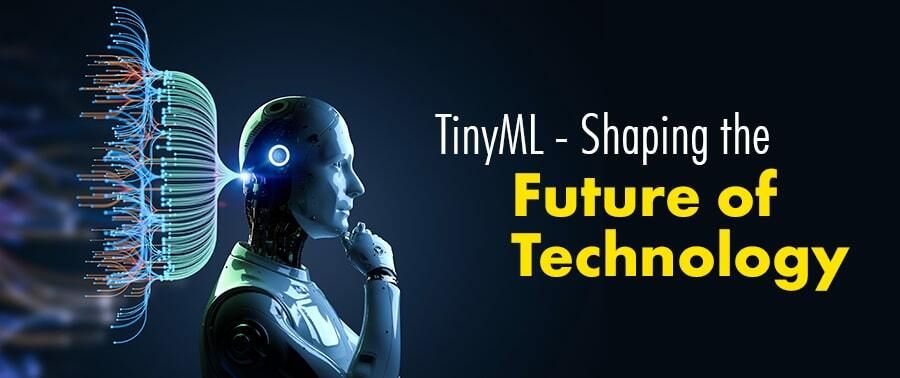TinyML, sounds like something fun and cute, right? Well, fun, yes! But the other word I would rather associate with TinyML would be enormous.
Enormous? For something that is called TinyML, yes indeed! This new technology has advanced at a rapid pace over the space of a few years and has had an enormous impact on multiple industries.
Tiny Machine Learning or as it is commonly called, TinyML is a field of study about Machine Learning and Embedded Systems. It explores the various models you can run on devices such as microcontrollers. The key feature of this technology is that it enables low bandwidth, low latency, and low power model inference at edge devices.
Mind all boggled up? Don’t worry, in this blog, we will help you grasp the concept of TinyML and gain a great number of ideas about it ranging from
- What is TinyML?
- How do we use this new technology? What are its applications?
- Industries that currently use TinyML
- What are some of its advantages
So, let’s get right into the crux of it.
What is TinyML?
Imagine you click an image from your smartphone or say ‘Hey Siri’ and instantly there is a response from your device in both cases. Now imagine if it took a relatively longer time for the response to arrive, poor User Experience, right?
This is how TinyML found its demand. Whether it is the machine learning that needs to take place when you click a picture or for your virtual assistant to respond, everything needs to happen locally on your device in an instant. If your smart device had to send your input to the servers, where the information would be processed and then provide you with output, it wouldn’t have been referred to as a smartphone then, right?
TinyML solves this problem as it applies machine learning algorithms and models to devices that have a limited number of resources. These devices have limited energy resources, computational power, and memory. Now with the help of TinyML, such devices can carry out inference tasks from the resources locally available and do not need to rely on cloud-based servers.
The two main factors that led to the emergence of TinyML are: -
- Real-time decision-making at the edge of the internet
- Need for localized intelligence
You now have an idea about what TinyML is and why it has emerged significantly in the past few years. Now let me give you a brief about how a technology that is called tiny can do such heavy lifting!
How do we use TinyML? What are its existing uses?
Firstly, while it may sound how convenient it is to deploy TinyML in low-powered devices, it isn’t nearly easy to do it. A variety of techniques and approaches are used in TinyML for it to work effectively on resource-constrained devices.
While specialized hardware is developed and software frameworks created with a customized approach to efficiently execute these models on power-constrained devices, the other techniques utilized include: -
- Compression
- Model Optimization, and
- Quantization
The main aim of all these techniques is to trim down the computational complexity of machine learning while still maintaining high accuracy levels.
So long story short, it isn’t easy to deploy TinyML in low-powered devices but at the same time, it is crucial to do so, and so we have once again found a way to execute our dreams!
Let us now explore some of the real-life applications of this technology and the various industries which make the most out of TinyML.
- Predictive maintenance
- Voice commands
- Gesture recognition
- Sensor data processing
- Activity tracking
These five are arguably the most common applications of TinyML in the current day. Industry giants such as Apple and Google also use this technology in advancing their products and enhancing user experience.
Industries that currently use TinyML
Whenever mankind has had a technology of such great use in its hand, it has unquestioningly made the most out of it. The case isn’t any different on this occasion as well. Several industries have been revolutionized since the introduction of TinyML. Let us explore how these industries have incorporated Tiny Machine Learning into their products.
Consumer electronics – With the popularity of products such as smart speakers and wearables like smartwatches increasing at a rapid rate, the consumer electronics industry has enjoyed great growth of late.
Now what you may not know about this industry is, it uses TinyML at a great scale in manufacturing various products. All of the intelligent home appliances can recognize our voice and detect our location thanks to the capabilities of TinyML. Moreover, some devices are also able to process photos and videos owing to TinyML embedded in them.
Agriculture – When it comes to the integration of technology and agriculture, the Nuru application has been the talk of the town. Now this application helps farmers by detecting diseases in plants, and it can do so just by taking a picture of the plant.
The application produces results owing to the TinyML embedded in it, and as the Machine Learning model runs on the device of the farmer itself, there is no need for a heavy internet connection as well.
While you may not recognize the importance of this feature, in remote areas where many farmers live, the internet isn’t always readily available, and TinyML once again saves the day.
Healthcare – For centuries, mosquitoes have been the root cause of many diseases affecting us humans. In the recent past, The Solar Scare Mosquito project was devised to curb the spread of mosquito-borne diseases such as Malaria, Dengue, and others. As you must have guessed by now, this project too incorporates the use of TinyML. It uses TinyML to detect conditions where mosquito breeding can take place. Moreover, this project as its name suggests, runs on solar power and can thus run indefinitely.
By now, you have acquired a healthy amount of knowledge about TinyML and its uses.
Let me now share with you some of the advantages of TinyML that have encouraged us to use it.
Advantages of TinyML
Low Bandwidth – With TinyML data processing can take place locally and the data need not be sent to the server, thus using lesser internet bandwidth.
Privacy – Another advantage of the data not being sent to the servers is, your privacy is upheld as your data has zero chances of being stored on the server.
Low latency – The data being processed locally itself, reduces the response time for the output and thus the latency is relatively low when compared to data being sent to servers for processing.
Reduced power consumption – Many embedded systems that use TinyML aren’t connected to a power source and run on battery. TinyML is critical in such systems as its algorithms are energy efficient and carry out their operations while minimizing computational load, thus reducing power consumption.
Final Word
The advent of TinyML has undoubtedly been a breakthrough in the field of Machine Learning. It enables low-powered devices to function on their own without being connected to a server. The technology enables devices such as wearable devices and microcontrollers to recognize speech or images without using a lot of power. TinyML holds great potential as the consumer electronics industry keeps expanding year-on-year.
With a bright future ahead, TinyML can successfully transform the way we work and live as it becomes more widely adopted.





Top comments (0)